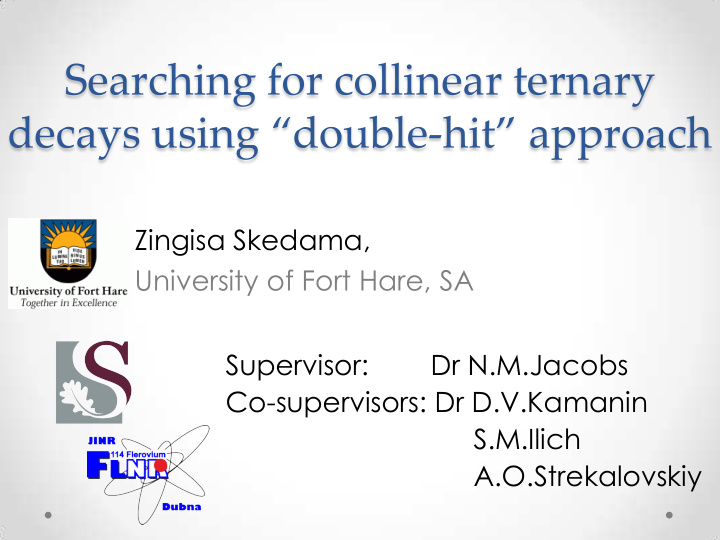



Searching for collinear ternary decays using “double - hit” approach Zingisa Skedama, University of Fort Hare, SA Supervisor: Dr N.M.Jacobs Co-supervisors: Dr D.V.Kamanin S.M.Ilich A.O.Strekalovskiy
Background and Motivation
Binary fission Nuclear fission, the main process generating nuclear energy, was discovered in 1938. This is a process where a heavy nucleus such as Uranium decays into two fragments of about the same mass – so called conventional binary fission.
Ternary fission However fission for more than two fragments may occur. For example ternary fission – very interesting phenomenon from the scientific point of view. Fig.1 Schematic view of possible modes of ternary fission
Ternary fission It was found that the fission barrier in the case of oblate configuration is higher then that in the prolate configuration. Thus prolate (collinear) configurations are more profitable energetically for ternary fission. [Die73] Diehl H., Greiner W. Ternary fission in the liquid drop model, Phys. Lett. B. 45 (1973) 35. [Die74] Diehl H., Greiner W., Theory of ternary fission in the liquid drop model, Nucl. Phys. A. 229 (1974) 29. Fig.1.2 Schematic view of possible modes of ternary fission
Ternary fission And fission process with three fragments of comparable mass with comparable relative angles (as a “star”) – so called “true ternary fission” - was not observed on the level of 10 -8 per fission. Fig.1.3 Schematic view of possible modes of ternary fission
Ternary fission The name “ternary fission“ is nowadays usually applied to process, where light nuclei ( 6 He – 28 Mg) are observed mostly perpendicular to the axis defined by the two heavy fragments.
Ternary fission: motivation But “true ternary fission” was discovered in Flerov lab as collinear cluster decay and named Collinear Cluster Tripartition (CCT). However evidence for third fragment was obtained in the “missing - mass” approach. It means that only two of the three fragments was detected. Thus direct detection of all fragments in CCT is an actual scientific problem. Collinear Cluster Tripartition (CCT)
Direct detection of all fragments in CCT The solution of this problem is not so simple. According to studies of CCT the relative angle between two fragments flying in the same direction determined by the scattering in the backing of the Cf-source and it is less than 1 ° . Due to that it is very complicated to design experiment where all particles will be directly detected. If β =1 ° , to register two fragments separately in standard silicon detectors L1 must be > 57 cm (because L2 > 5 mm). Det1 Big distances => small flux => long experiment L2 β ~ 1 ° Det2 L1
Direct detection of all fragments in CCT So one way to solve the problem is double-hit registration mode of data acquisition system which will give ability to register two collinear fragments in one silicon detector. Det1 β ~ 1 ° L1 Time axis
Experiment The special setup named LIS was used for this purpose. MCP2 PIN1 MCP1 St PIN2 252 С f Photo of the spectrometer
Experiment Schematic view of LIS setup is shown below. It consists of two silicon PIN-diodes (red) and three Time-Detectors based on microchannel plates (yellow). Cf-source fixed on Start-Time detector in the center. All detectors connected to preamplifiers inside the vacuum chamber.
Experiment Data acquisition system consists of CAEN flash-ADC attached to PC. CAEN flash-ADC, 5 GHz sampling rate 200 ps per point Flash-ADC gives possibility to operate with shape of each signal. Preamplifiers with sharpest shape of signal was used.
Experiment So the typical picture of signals in one event looks like this: PIN1-signal Start Amplitude axis TimeDetector1 TimeDetector2 PIN2 Time axis
Data processing: results And double hit events was found ! Pile-up PIN1-signal DoubleHit ! Amplitude axis TimeDetector1 Time axis
Data processing: results The shape of signal for double-hit event in silicon PIN-diode was modeled according to data from previous experiments. This pile-up shape is presented in this picture: Threshold level for detecting of the pile-up FF approximately dTOF~ 30ns at A1/A2=10 (i.e. if energy of third fragment is 10 times less then the other). The possibility of separation of signals in PIN-diode need to be checked using conservation laws.
Conclusion 1. Approximately sixty double-hit events were detected by the timing MCP based detectors using fast flash-ADC. 2. Parameters of the events observed agree with the predictions based on data from previous experiments treated as the results of ternary decays (CCT). 3. The number of found events gives probability of the CCT about 10 -4 relative to the binary fission which has good agreement with predictions. 4. More detailed analysis of the double-hit events detected still in progress. Verification of conservation laws can give information about mass of third fragment.
Thank you for your attention! Zingisa Skedama, University of Fort Hare, SA
Recommend
More recommend